| An Insane Asylum in Winthrop |
Some of earliest photographs of Winthrop were taken in 1868 as part of a marketing effort aimed at convincing Boston officials that the Winthrop Highlands would be the best location for a new asylum for the insane. Overcrowding at the asylum in South Boston was noted as a problem as early as 1853 when a committee was formed to explore and encourage the building of a new facility. It wouldn’t be until 1865 that the Board of Directors of Public Institutions was given authority to select a site, purchase land, and hire an architect to draw up plans for a new building. Edward R. Snow takes up the story in his 1939 Boston University Master of Art thesis on the history of Winthrop:1 |
| “Dr. Walker, the Superintendent of the Lunatic Asylum in Boston, was eager to establish a new hospital in Winthrop. Many on the committee for the new hospital were against locating on what they regarded as the wastelands of Winthrop Highlands, and Dr. Walker had a hard fight on his hands to win over the Council members so that they would make the journey down to the location.” |
| Dr. Walker's efforts included hiring a photographer to take pictures from the location. Snow's description of the photographs are used as captions for the six pictures below: |
| “The photographer set his tripod down and faced his camera lens toward the south.” |
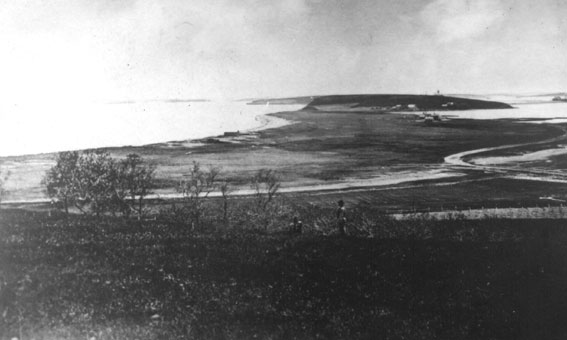 |
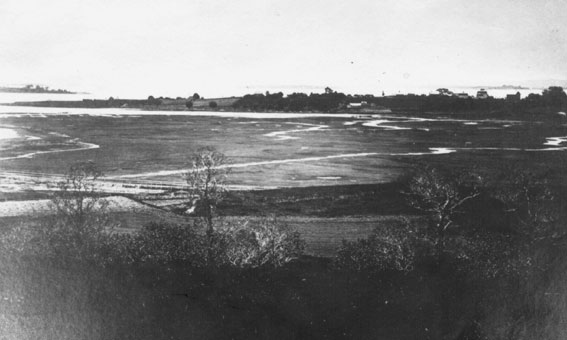 |
| #1 -“...He then swung a little to the eastward to take in the full sweep of the beach. John Flanagan’s house and barn, John W. Tewksbury’s residence. Green Hill, and Deer Island Hospital were all in the range of his camera, with the hut of the Massachusetts Humane Society, of which John Flanagan was the keeper, located on the beach. Shirley Street was in the right foreground with Taft’s Hotel barely showing in the distance...” |
#2 - “The camera swung again to the west, describing an arc of approximately thirty degrees before it was focused for the second view. This time most of Point Shirley, the present River Road section of Winthrop, together with what is now the Winthrop golf course was visible...” |
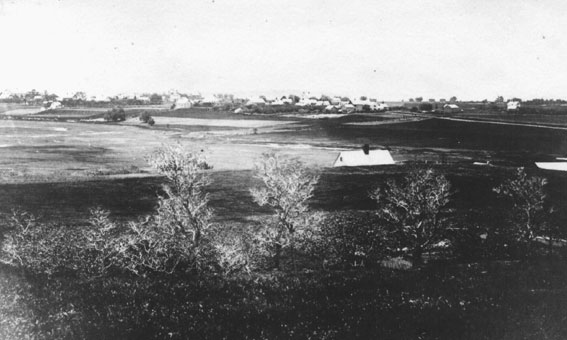 |
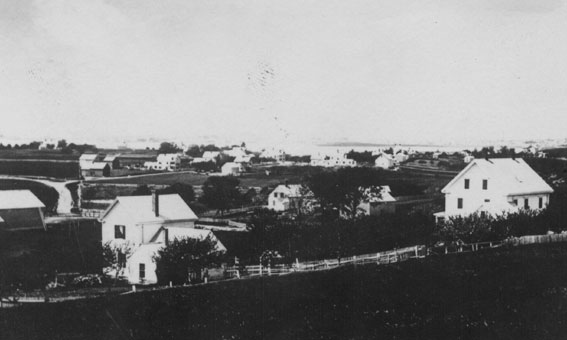 |
| #3 - “Again the camera was swung thirty degrees, this time facing the Cottage park and Court Park section with the ancient Deane Winthrop house in the central foreground. ” |
#4 - “The photographer now faced due east. Magee’s Corner with Shirley Street and Main Street and a score or more houses, with East Boston and part of Orient Heights showing in the distance, was now photographed...” |
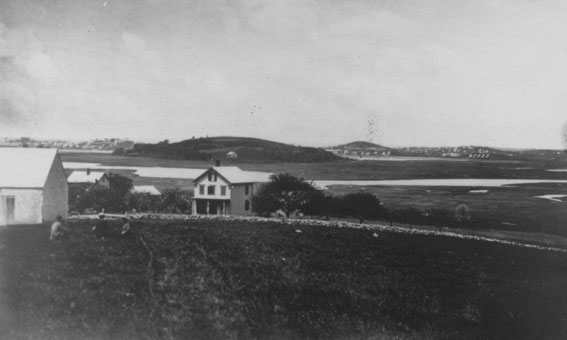 |
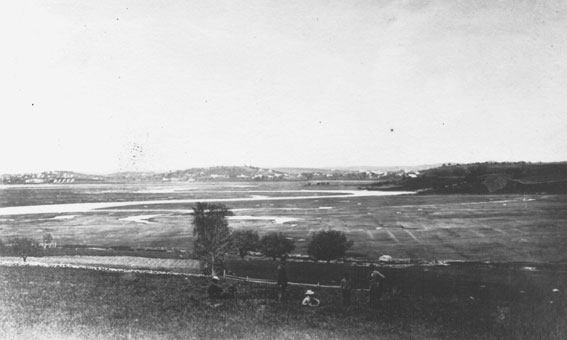 |
| #5 - “Thirty degrees father to the north another picture was taken showing Breed’s Hill and the old barn in Orient Heights.” |
#6 - “The final picture was taken of the former Crooked Lane, now called Belle Isle Inlet, flanked by Beachmont at the extreme right.” |
| The doctor was Clement A. Walker, born in Fryeburg, Maine in 1820, he had graduated from Dartmouth in 1842 then received a medical degree from the Harvard Medical School in 1850.2 He was appointed superintendent of the Boston Lunatic Asylum in 1851. Earlier he had volunteered during a cholera epidemic at a hospital located on Deer Island. It had been built in 1847 to screen and treat the thousands of immigrants that were arriving, many refugees from the Irish Potato Famine, and many sick and poverty-stricken. The hospital would transition to becoming a House of Industry, an institution that combined the functions of an almshouse and a workhouse. It would later become a House of Correction holding people convicted of crimes subject to relatively short-term sentences. Dr. Walker’s Lunatic Asylum was located in South Boston on property that also included another House of Industry, a House of Correction, and a House of Reformation for juveniles. |
| Overcrowding at the asylum was noted as a problem as early as 1853 when a committee was formed to explore and encourage the building of a new facility.3 It wouldn’t be until 1865 that the Board of Directors of Public Institutions was given authority to select a site, purchase land, and hire an architect to draw up plans for the new building. |
| For plans, the committee turned to the Boston architect Nathaniel J. Bradlee (1829-1888).4 Records of the design he came up with for the new facility in Winthrop are bot available. What is known is that when the Danvers State Hospital was built in 1874, Bradlee was architect and same plans were used in its design.5 In the mid-19th century the popular design for new mental asylum buildings was known as the Kirkbride Plan, named for a Philadelphia psychiatrist, Thomas S. Kirkbride (1809-1883). In his book, “On the Construction, Organization, and General Arrangements of Hospitals for the Insane”,6 published in 1854, he recommended a large building with housing in numerous staggered wings laid out in a “bat wing” style plan. It would give patients access to sunlight and air ventilation, which he believed aided in healing the mentally ill. He also thought the grounds should be a minimum of 100 acres where foliage and farmlands could be maintained by patients. |
| Locations under serious consideration included; Breed’s Hill, today’s Orient Heights; the Codman Estate in Dorchester, the home of Rev. John Codman (1782-1847); and Winthrop Farm, the most northernly portion of the land formerly owned by Deane Winthrop.7 Dr. Walker and his colleagues selected Winthrop Farm. It was cheapest at $25,000, the Codman Estate was valued at $100,000 (price latter dropped to $55,000), and Breed’s Hill at $250,000. The Codman Estate, at 70 acres, was also too small, and in the case of it and Breed's Hill, development plans in the works made it evident to the selection committee that the areas would not remain secluded for long, an important consideration. At 180 acres the Winthrop Farm location was more than large enough, and “so situated that it can never be annoyed by settlements in close proximity.”8 |
| Another factor in favor of Winthrop Farm was the Boston House of Industry located on Deer Island. To support the facility, Boston already was paying to repair the bridge between East Boston and Winthrop, and for work on a pier at Shirley Gut. |
|
| Camera viewing angles - 1859 map |
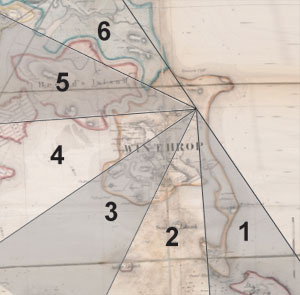 |
|
| Camera viewing angles - Modern image |
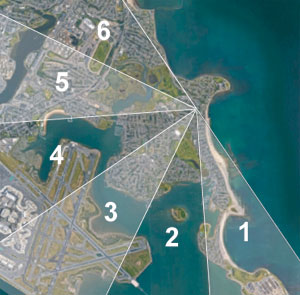 |
|
| Were there more photographs? |
Only the six photographs shown above are identified as the ones Dr. Walker used to promote the Winthrop Farm site. They all look to the west and slightly southwest. None look to what people today most likely would consider the best view, out to the east with its 180-degree panorama view of the ocean. For Dr. Walker, that view to east was the problem. One of major criticisms of the site was its exposure to ocean storms, though as one Boston City Councilor pointed out, Winthrop Farms was not as exposed as the existing facilities on Deer Island. |
|
|
| In 1866 Winthrop Farm was purchased by the City of Boston for the $28,108.33.9 |
| With land purchased and plans drawn up, the committee was ready to proceed with the construction of the new Insane Asylum at Winthrop Farm. The initial cost estimate for the building was $500,000,10 $8.5 million is today’s money, and that did not include site preparation and other costs. Danvers State Hospital, when it was built less than 10 years later, cost $1.5 million. The debt that the City of Boston would have to take on did not sit well with its new mayor, Otis Norcross (1811-1882). A one-term mayor, from Jan. 7, 1867 to Jan. 8, 1868, he was from a Boston Brahmin family that became wealthy importing and selling fine European, Japanese and Chinese china and pottery. With other projects, such as filling in portions of the Fort Point Channel and the Back Bay, requiring spending enormous amounts of money, he vetoed the expenditure of money to build a new insane asylum.11 His fiscally conservative view was that the State should pick up more of costs, which it ended up doing when Danvers State Hospital was opened in 1878. |
| In 1869 the proponents of building the new insane asylum in Winthrop continued their efforts, but resistance was mounting. The new mayor of Boston, Nathaniel B. Shurtleff (1810-1874), in his inaugural address bemoaned the overcrowding problem, but only suggested that 11-acre Rainsford Island far out in Boston harbor could be used for the “treatment and reformation of inebriates.”12 In the Boston City Council dissenters saw their chance and reintroduced the idea of building the new facility on either Breed’s Hill or at the Codman estate. Roxbury resident, and future Boston mayor, Samuel C. Cobb (1826-1891), as a City Councilor unloaded on the selection of Winthrop saying for a short time in summer the location is favorable, but from November to June, the winds on the exposed ground would, “test the power of human endurance… most of the soil is poor, a mere sheep pasture…neither trees or shrubs have been able to stand against the fury of the northeast storms…and...the view if the surrounding country is not particularly attractive…”13 He preferred the Codman Estate where the former mansion could be used to “good advantage,” seemingly unaware of what the doctors who were attempting to implement the Kirkbride plan. |
| To complete his criticism of the Winthrop Farm location, Cobb submitted a letter written by the eminent Winthrop citizen, George B. Emerson (1797-1881). In it, Emerson says he, “never saw a place more unfit for anything but a lighthouse or a beacon…there are few days in winter where it would be safe for any but a strong man to walk out… there is scarcely a vestige of a tree… as bleak, boisterous and inhospitable as Greenland.”14 Then Emerson says he once brought Dorothea Dix (1802-1887), renowned Civil War nurse and advocate for the mentally ill, to the site and she didn’t approve as a location for a hospital or asylum. |
| Promoters of the site responded, including meeting with Emerson who muted his criticism and, possibly suggesting an ulterior motive, offered that his 32-acres estate, available for $26,000, in addition suggesting that the neighboring estate of Edward G. Loring (1802-1890) might be for sale, and would be a better location for the asylum.15 Two members of Winthrop Citizen’s Committee, John Belcher and Samuel Ingalls, submitted a letter saying that the soil was fine and there have always been beautiful pastures and productive orchards on Winthrop Farm.16 There was even talk about annexing Winthrop as part of Boston.17 Finally, an exasperated Melville E. Ingalls, a City Councilor whose Ward included the Codman Estate, which he supported, commented on the criticism of the Winthrop Farm site saying, “If Winthrop Farm was not fit for human habitation, then the city for years has been murdering its paupers on Deer Island, an no complaints have come up against such slaughter.”18 |
| Dr. Walker retired in 1881. By 1878 the Danvers State Lunatic Asylum would open with some Boston patients transferred there. In 1887, the former Home for the Poor at Austin Farms in Roxbury became an outlying ward of the Boston Lunatic Hospital. Then in 1892 the nearby Pierce Farm was purchased, and buildings constructed. In 1951 the resident population of the hospital hit an all-time high of 3,100, overcrowded by 30%.19 |
| Why wasn’t Winthrop Farms selected as the site for a new insane asylum? Mary P. Griffin in her 1905 book, Winthrop Days,20 credits the opposition of prominent Winthrop resident George Emerson, and reported opposition Dorothea Dix, with stopping the project. She appears to have been unaware of Emerson’s possible self-interest in promoting his estate in Winthrop for the asylum. One can only guess what her opinion of Emerson would have been if today’s upscale Court Park neighborhood had been selected. She also did not note the support for the project by others in the town. Edward R. Snow in is college thesis, and William H. Clark in his 1952 book, The History of Winthrop, Mass.,21 both say that important doctors on the committee did not approve of the site. That appears to be inaccurate. Boston City Councils records show that doctors on the committee did support Dr. Walker in favoring Winthrop Farm.22 Finally, the 2002 Town of Winthrop Sesquicentennial Commemorative Book,23 gives the reasons that the site was too far from the city and too close to the ocean. Though the Winthrop Farm was closer than a trip by land to Deer Island facility, and not as close to the ocean. |
| Ultimately the reason Winthrop Farms wasn’t selected was most likely due to politics. What politician in his right mind would want to argue for spending millions of dollars on a facility that wasn’t even in the city? And a facility for who? Patients at insane asylums are clearly not an important voting group. While it was noble for politicians to give speeches that complain about overcrowded conditions, one has to question their sincerity if their solution is to build a facility on a distant harbor island. |
| In 1883 Boston would sell the land to the shoe magnate William B. Rice for $80,000. In 1878 he and his Winthrop Shore Land Company had purchased Great Head, subdivided it, and changed its name to Cottage Hill. Winthrop Farm would be sub-divided for development and renamed Winthrop Highlands. |
|
|
The origins of Winthrop Farm
The original name given to the town of Winthrop by the Puritan settlers was recorded at the time as Pullen Poynte, a misspelling of Pulling Point. Strong tidal currents through the narrow channel between Deer Island, named for deer that would swim the channel to escape wolves, and the mainland would on occasion make it necessary for sailors to use ropes to pull their boats through the gut. It would be named Shirley Gut after a visit to the area by Massachusetts Bay Colony Governor William Shirley (1694-1771) at the establishment of a fishing station there in 1753. The town wouldn’t be called Winthrop until it was incorporated in 1852. |
| Much earlier, in 1637, all the land of Pullen Poynte was allocated to 15 men, one of whom was Massachusetts Bay Colony Governor John Winthrop (1587-1649). When he died, he handed down the land to his sixth son Deane Winthrop (1623-1704), who in turn bought more property extending his land ownership to the whole length of the town. The area became known as the Winthrop Farm. After his death, the land was sold off except for the area that would be of interest to Dr. Walker 200 years later. That land was the remaining piece of the original Winthrop Farm. |
|
The area today is called the Winthrop Highlands and consists of three hills, one of which has been partially washed away by the ocean. Topographically, the hills are drumlins formed by the glaciers and are members of what is known as a drumlin swarm. An expression that describes a series of drumlins that all face in one direction, an indication of which way the glacier that created them moved. Other hills in the swarm are; Orient Heights in East Boston; Beachmont, Youngs Hill, and Fennos Hill in Revere; Mount Washington in Everett; and Powder Horn Hill in Chelsea. Of the three Winthrop Highlands hills, only one is officially named by the U.S. Geological Survey’s Board of Geographic Names, and it’s not a hill, it’s a cliff, Grovers Cliff, named for Jotham Grover (1659-?). He married Margaret Winthrop (1660-1695), the daughter of Deane Winthrop. The USGS database does include Winthrop Highlands but identifies it as a Populated Place and puts its location near the remnants of the hill being washed away to form Grovers Cliff. |
| There is no site plan yet found that shows exactly where the Lunatic Asylum was to be located in Winthrop Farm. There are floor plans for building, and details of its construction down to the 7,750,250 bricks that would be needed. It’s likely that the building was to be located near the summit of the hill where the photographs were taken. That hill, and the other hill that makes up the Winthrop Highlands, are not the USGS database of geographic names. The hill where the photographs were taken is often labelled Floyd’s Hill on maps. This for the Floyd family that owned the south side of the hill. Houses on streets laid out in the area are visible in photographs numbers 4 and 5. None of the photographs show the area around Grovers Cliff, and only the last picture, number 6, shows a small portion of the other hill that makes up the Winthrop Highlands. On maps it is sometimes labelled Prospect Hill or Mount Fairview, both referring to the wide area visible from its summit. |
|
| Footnotes |
| 1 |
History of Winthrop, Massachusetts, Edward Rowe Snow, Boston University Masters Thesis, 1939 - Internet Archive |
| 2 |
Obituary, Dr. Clement A. Walker, Descendants of David Evans of Charleston, Mass., pg. 20, Simeon A. Evans, 1898 - Google ebook |
| 3 |
Report of Committee on the Subject of New Lunatic Hospital, City of Boston Document No. 58, 1853 - Internet Archive |
| 4 |
Plans, Descriptions and Estimates of the Boston Hospital for the Insane at Winthrop, Clement A. Walker, Insanity and Insane Asylums, pg. 339, 1867 - Google ebook |
|
Nathaniel Bradlee - Danvers State Insane Asylum |
| 5 |
History - Danvers State Insane Asylum |
|
History, Danvers State Hospital, Richard B. Trask, 1981 - Danvers Archival Center, Peabody Institute Library |
| 6 |
On the Construction, Organization, and General Arrangements of Hospitals for the Insane, Thomas S. Kirkbride, 1854 -Internet Archive |
| 7 |
Site for a Lunatic Hospital, City of Boston, Proceedings of the Common Council, pg. 266, Oct. 28, 1869 - Internet Archive |
| 8 |
Ibid, pg. 287, Nov. 25, 1869 - Internet Archive |
| 9 |
New Lunatic Hospital, pg. 276, City of Boston Annual Report of Receipts and Expenditures, FY 1871-1872 - Internet Archive |
| 10 |
The Inaugural Address of Otis Norcross, Mayor of the City of Boston, pg. 29, 1867 - Google ebook |
| 11 |
In Memoriam, Otis Norcross (1811-1882), pg. 78, pg. 93, 1883 - Internet Archive |
| 12 |
The Inaugural Address of Nathaniel B. Shurtleff, Mayor of the City of Boston, pg. 86, 1870 - Google ebook |
| 13 |
Site for a Lunatic Hospital, City of Boston, Proceedings of the Common Council, pg. 290, Nov. 25, 1869 - Internet Archive |
| 14 |
Ibid, pg. 303, Dec. 9, 1869 - Internet Archive |
| 15 |
Ibid, pg. 309, Dec. 16, 1869 - Internet Archive |
| 16 |
Ibid, pg. 309, Dec. 16, 1869 - Internet Archive |
| 17 |
Ibid, pg. 289, Nov. 25, 1869 - Internet Archive |
| 18 |
Ibid, pg. 324, Dec. 23, 1869 - Internet Archive |
| 19 |
Boston State Hospital - Asylum Projects |
|
Guide to the Boston Lunatic Hospital at South Boston records (PDF) - City of Boston |
| |
1898: Boston’s Pauper Institutions - Senior Living |
| 20 |
Winthrop Days, And A Half Century With The Trees - 1855-1905, Mary Priscilla Griffin, 1905 - Winthrop Public Library & Museum |
| 21 |
The History of Winthrop Massachusetts, 1630-1952, William H. Clark, 1952 - Winthrop Public Library & Museum |
| 22 |
Site for a Lunatic Hospital, City of Boston, Proceedings of the Common Council, pg. 296, Dec. 2, 1869 - Internet Archive |
| 23 |
Town of Winthrop Sesquicentennial Commemorative Book, 1852-2002, 2002 - Winthrop Public Library & Museum |
| |
|
|
|